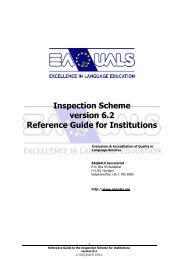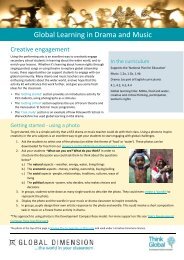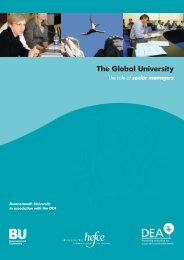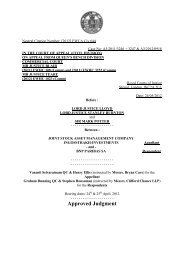2 Recognise that strong values groundedin reality are the drivers of changeValues become powerful drivers of change whenthey are connected to the realities everyone cansee. Our young people face an unprecedentedcrisis of opportunity with one million unemployedand the prospect of being part of a generationthat could be poorer than their parents. Herewe can lead with the values of fairness and intergenerationaljustice as a call to arms3 Look for the different ‘adhesives’ thatbind us togetherThe left is understandably concerned about institutionaldiversification and the lack of democraticaccountability that exacerbate social differencesin localities. In response, it has traditionallyprioritised one type of ‘glue’ – fair admissionspolicies and the ideal of the common school.While these are worth fighting for, we also needto look to different types of glue or ‘frameworks’that bind people together. These include a moreunified 14+ curriculum, more equitable fundingentitlements and institutional commitment toall students in an area. There are many differentdimensions of ‘comprehensiveness’ and we mustexplore the power of them all and particularlyhow they might work in combination.4 Realise that education can changesociety, but only under certain conditionsBasil Bernstein’s famously pessimistic statement‘education cannot compensate for society’ hasbeen countered by politicians who think it canachieve everything, hence Tony Blair’s ‘education,education, education’. Here we suggest, followingEwart Keep in this volume, that education can bea vital contributor to transformation so long as itis part of a wider political, social and economicstrategy. In this sense, education is at its mostpowerful when it is allied with other strandsof reform. Education for the Good Society,therefore, is an integral part of a wider societalvision of change.5 Understand what the central stateshould and should not doSome on the left are still obsessed with centralismand demonstrate weakness when it comes todemocratic intent. We should be reducing thepower of the state away from the centre so thatits role in guaranteeing fairness and standardsis balanced by greater powers exercised by awider range of social partners and in localities.This is what might be referred to as ‘democraticlocalism’. Social democratic and progressivepolitical parties should commit themselves togiving meaningful power to the local level wherethere are many local authorities, schools andcolleges, civil society organisations and parentstrying, often against the odds, to implement acomprehensive ideal.Towards an expansive and comprehensivevision – seven fundamental idealsThroughout the various chapters of this book, aset of comprehensive values for the modern agehas been proposed as part of the building of theGood Society. Some of these are not new, representingthings from the past we should cherish;some have flourished in recent years at the locallevel, but have not informed national policy; andsome are in their political infancy. Rearticulatingthemes from the first chapter, here are sevento start with: they span different phases andlocations of education and training and representvarious dimensions of what might be regarded asa truly ‘comprehensive’ system of education.1 The belief in educability and humanpotentialFundamental to any progressive and inclusivevision of education is the belief in ‘educability’;that everyone can benefit from education in allits forms; that everyone can think as well as do;and that education in this form can support individualwellbeing, reinvigorate communities andtransform society. Such a belief strengthens theresolve to extend education throughout the lifecourse,to link general and vocational educationand to have a deep commitment to those withspecial education needs.2 Educating for togethernessHow can we encourage togetherness in a worldof growing institutional diversity? The key maylie in the values of togetherness and fairness andactively promoting a wider sense of responsibilitythat institutions should cater for all types oflearners or, in the case of post-14 education andEducation for the good society | 59
training, be part of a local system that does. In aworld of academies, free schools and state schools,school sixth forms, colleges and the workplace,we have to find the glue. Any local regulationaround admissions by reinvigorated local authoritieswould have to be based on a strong moral andeducational case. Rather than seeing commonalityas imposed from above, we need to createthe situation where government empowers thosewho seek fairness and cohesion from below. Thissuggests that a moral and political battle has toprecede organisational change and a recognitionthat educating for togetherness takes place indifferent ways. Commonality and cohesion canbe pursued, for example, through the notion ofthe ‘strong area’, in which diverse institutionscollaborate. In the current or foreseeable politicalcontext, the idea of the strong area or locality mayhave to prefigure the eventual widespread developmentof the ‘common school’.3 A more common, yet more openform of learningThe left has traditionally tended to overestimatethe reforming power of organisation and underestimatedthe power and controversy of the curriculumand of pedagogy. What should be taughtand how learning should take place has become apolitical battlefield. As Martin Yarnit observes inChapter 11, education is full of unnecessary polarities.It is here that we have to show the greatestimagination as we try to turn the term ‘versus’ into‘and’. It would seem that the fundamental valuesof educability and togetherness point us towardsa relationship between apparent opposites. Onthe one hand, education is about what we share incommon. On the other, innovation and maturationlead to specialisation and diversity. We haveto relate the two. A comprehensive curriculumwould need, therefore, to be underpinned by anew set of balances – knowledge and skill; understandingthe past and discovering the new; theindividual learner and the curriculum; fosteringlearning for its own sake and understanding thepower of relevance; individual subjects and theirintegration; the value of established texts and theopen excitement of the web.4 Educators and democratic relationshipsWho is best placed to make sense of all of this?It is well-trained professional educators, collaboratingwith others and through the art of teaching,who translate these opportunities into practicesthat meet the needs of their students. Thus farunfortunately, teachers and lecturers have spenta good part of their time and energy on policydamage limitation. A new approach to policymakingcould slow down the rate of change andcreate new freedoms of interpretation in orderthat professionals can play a full role in the policyprocess. The kind of ‘democratic fellowship’Michael Fielding has talked about in Chapter 7 inrelation to students can be broadened to includea range of educational relationships.5 The Good Economy and the potentialpower of ‘situated learning’Learning is about much more than schools,colleges, universities and their teachers andlecturers, critical though they are. The mostpowerful forms of learning can take place outsideeducational institutions – in the workplace, thehome and community, through a variety offormal and informal learning opportunities. Seenin this way, the role of educational institutionsis to prepare people to take advantage ofthis learning landscape although all too often,because they are pressurised by national examinationsand other accountability mechanisms,these institutions fail to fully grasp this essentialpoint. Learning in this wider sense, however,does not happen by chance. It has to be fostered.Here workplaces can play a fundamental role, butthese have to be places that offer expansive ratherthan restrictive learning opportunities.6 Lifelong learning: the ultimate comprehensiveidealA commitment to education throughout the lifecoursecan be regarded as the ultimate comprehensiveideal. Among its many virtues is thefact that lifelong learning can re-engage thosewho did not succeed in school as well as providesupport for individual and community wellbeing.7 Thinking ecologicallyThe ideals discussed here could also be viewedas part of an ecological perspective on education– the nurturing of balance, evolution, interdependence,adaptation and resilience. We haveto now make critical choices– either educationcan be about the reproduction of the divided60 | www.compassonline.org.uk
- Page 1 and 2:
Educationfor theGoodSocietyThe valu
- Page 3 and 4:
Acknowledgements:Compass would like
- Page 5 and 6:
ContributorsLisa Nandy is Labour MP
- Page 7 and 8:
IntroductionEducation for the Good
- Page 9 and 10: 1 This article has been developedou
- Page 11 and 12: 8 See Ann Hodgson, Ken Spoursand Ma
- Page 13 and 14: 13 The most comprehensiverecent res
- Page 15 and 16: 1 See for example B. Simon, ‘Cane
- Page 17 and 18: 10 J. Martin, Making Socialists: Ma
- Page 19 and 20: the poorest homes (as measured by e
- Page 21 and 22: 1 In 2008, 15 per cent ofacademies
- Page 23 and 24: 1 Angela McRobbie, The Aftermathof
- Page 25 and 26: 8 Christine Skelton, Schooling theB
- Page 27 and 28: 1 See www.education.gov.uk/b0065507
- Page 29 and 30: 13 Barbara Fredrickson, ‘Therole
- Page 31 and 32: 6. Education forsustainabilityTeres
- Page 33 and 34: well as cognitively. Real understan
- Page 35 and 36: 7. Schools fordemocracyMichael Fiel
- Page 37 and 38: and joyful relations between person
- Page 39 and 40: 8 Wilfred Carr and AnthonyHartnett,
- Page 41 and 42: 1 Winston Churchill, quoted inNIACE
- Page 43 and 44: 9 See http://news.bbc.co.uk/1/hi/ed
- Page 45 and 46: 1 The Learning Age: A Renaissancefo
- Page 47 and 48: nities, and not have the public-pri
- Page 49 and 50: 4 Engineering flexibility: a system
- Page 51 and 52: other countries to require their re
- Page 53 and 54: 6. Remember that many of the outcom
- Page 55 and 56: 2 Adrian Elliott, State SchoolsSinc
- Page 57 and 58: 4 Peter Hyman, ‘Fear on the front
- Page 59: 12. Rethinking thecomprehensive ide
- Page 64: About CompassCompass is the democra





![[2012] UKUT 399 (TCC)](https://img.yumpu.com/51352289/1/184x260/2012-ukut-399-tcc.jpg?quality=85)





![Neutral Citation Number: [2009] EWHC 3198 (Ch) Case No: CH ...](https://img.yumpu.com/50120201/1/184x260/neutral-citation-number-2009-ewhc-3198-ch-case-no-ch-.jpg?quality=85)




